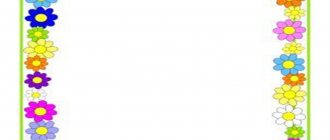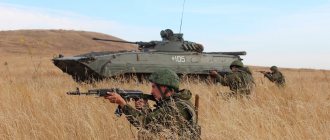Lesson “About volcanoes” for children
Experienced teachers have many ways to instill in a preschooler a love of science. These include working in a “children’s laboratory”, conducting scientific experiments, and simple experiments. By independently experimenting with substances and observing physical phenomena, children not only acquire knowledge about the world around them. They learn to think outside the box, exploratively, and can sometimes surprise with their logic.
One of the interesting topics about nature for children is volcanoes. The amazing world of these natural phenomena will not leave any child indifferent. And practical experience under the guidance of a teacher will delight even the most passive students.
Audience: preschoolers 5-6 years old
Props:
- Slides or posters about the structure of volcanoes, books about volcanoes for children, drawing sheets, pencils, markers, paints, brushes.
- Kit for conducting the experiment (basin or deep bowl, jar or bottle, water, cardboard, tape, soda, vinegar, dishwashing detergent, food coloring).
Progress of the lesson
The teacher begins the lesson with a riddle about a volcano:
-I throw stones, lava,
I am a dangerous giant!
Famous for its bad reputation.
What's my name? (Volcano)
- Children, today we will learn a lot of interesting things about volcanoes, what they are made of, how they sleep, erupt, and change the nature around them. In our laboratory we will conduct a magical experiment and see how lava flows out of a volcano, and at the end of the lesson we will have a quiz with questions about volcanoes. Do you love experiments and quizzes? At the end of the lesson, we will also play the game “Volcanologists”.
— What is a volcano? Maybe someone already knows?
This is a large natural mountain with a hole at the top from which hot streams pour out onto the surface of the earth.
— Where did the name Vulcan come from? The ancient people - the Romans - had a God of fire named Vulcan and he lived on the island of Vulcano in a country that is now called Italy. The god Vulcan commanded fire and lightning, and helped blacksmiths use fire to make objects from iron.
Here the teacher draws the attention of preschoolers to slides or posters about the structure of volcanoes.
—What does a volcano consist of? You and I already know that a volcano is a big mountain. It has a hole - a vent, from which hot, red-hot rock - lava - flows. The top of the vent is called a crater. It is located at the very top of the mountain. And below the mountain-volcano there is a huge cave with a hot substance called magma.
— Why do volcanoes erupt? Magma accumulates in the cave, begins to boil, rises up the vent and pours out onto the ground through the crater, turning into lava. Along with the magma, columns of smoke and volcanic ash erupt from the volcano, and hot stones fly. The whole earth around becomes gray and lifeless.
Physical exercise “Volcanic eruption”
- Let's imagine how a volcano erupts! Let's all sit on our haunches or on the floor. We are magma in an underground cave. Now let's start boiling and seething. We will splash our hands in the air and try to jump up. So the volcano is trembling, preparing to erupt. Now let our volcano burst out through the vent. Children jump up and raise their hands up. Magma poured out of the vent through the crater and spread over the ground, becoming lava.
Interesting facts about volcanoes
— And now interesting facts about volcanoes . They are active and dormant (extinct). Active volcanoes are those that have erupted in the last 10 thousand years and may still wake up and spew lava. Sleeping volcanoes will never wake up again. All volcanoes are studied by scientists - volcanologists; they are the ones who make predictions about what will happen next, whether the volcano will erupt or go dormant.
— The largest volcano on the planet, if you count the height from sea level, is Ojos del Salado . Its height is 6887 meters. It is located in South America and is considered dormant and extinct.
— The most dangerous volcano is located in Mexico, it is called Popocatepetl . Can you repeat this word? Volcanologists expect that he will someday wake up and erupt lava. Popocatepetl can kill a lot of people.
— In the Canary Islands there is a volcano on which a restaurant was built, and people cook food right on the fire of the volcano! They grill shish kebab and fish and treat the guests!
Now let's try to make a volcano erupt ourselves!
Children's laboratory experience
The teacher makes a model of the volcano in advance of the lesson or during the lesson with the children.
A basin or tray is placed on the table. This will be an island. The cardboard must be rolled into a cone and the seam sealed with tape or glue. The tip of the cone - cut off the crater with scissors. The cone can be coated with plasticine, so it will look like a real volcano. Place a bottle at the bottom of the basin under the cone, pour a tablespoon of soda into it, and pour in dishwashing detergent (25 ml). You can pour pebbles, sand into a basin around the mountain, and place animal figures. This way the picture will be more realistic.
In a mug, dilute food coloring (can be red or orange) with water and pour everything into a bottle under the volcano with the other ingredients. This way the magma will be ready.
And now the most important thing: pour vinegar into the mouth of the volcano and watch the eruption!
Here the teacher needs to be careful, it is important not to spill the vinegar and not allow the children to inhale this liquid.
Mixed with baking soda and dish soap in a bottle at the base of the volcano, the vinegar will create a rich foam from the volcano that will flow down the mountainside.
If you add baking soda and vinegar, the volcanic eruption can be repeated several times. Children will undoubtedly enjoy the spectacular experience.
After the experiment, it is advisable to ventilate the room.
Quiz
The quiz will help little researchers consolidate their acquired knowledge. Questions:
— Where did the name “volcano” come from?
— Which artisans did the god of fire help?
— What is the name of the hot substance in the cave under the volcano?
— What is the name of the long hole in a volcano through which magma rises?
- What is a crater?
— What does the magma that flows from the crater of a volcano turn into?
— What types of volcanoes are there?
—Who are volcanologists?
— What is the name of the largest volcano on the planet? Such a difficult word...
— What is the name of the most dangerous volcano?
Game "Volcanologists"
The most active participants in the quiz can be nominated as scientists - volcanologists. Let it be a girl and a boy.
Now you need to choose 3 - 4 strong boys who will firmly hold hands and form the mouth of a volcano. Their task is to hold their hands no matter what and not break the circle.
Volcanologists need to fill the volcano with magma. To do this, they call the rest of the participants into the mouth. A girl - a volcanologist - takes other girls by the hands and leads them into a circle - the mouth of a volcano. And the boy, a volcanologist, brings the boys, “pushing” them into the crater.
Circle - the muzzle stands firmly, without unclenching his hands. Children will have a lot of fun climbing into the circle and crowding around there; at this time the volcano is already seething, preparing to explode.
Everyone who did not fit into the crater can be called dinosaurs; they wander around the volcano. As soon as the vent overflowed, everyone who could entered the circle, the magma tore the vent - the volcano erupted, the children jumped out or fell out of the circle onto the floor. It's so fun!
Maybe now volcanologists themselves will choose an assistant and be the vent?
At the end of the lesson, the teacher invites the children to look at books about volcanoes for children with illustrations. Based on the knowledge they have acquired, children can themselves draw a volcano and the process of its eruption, using sheets of paper, paints, felt-tip pens, and pencils.
So, from the drawings in kindergarten, you will get an almost real scientific and educational exhibition about volcanoes for children.
Research work with presentation “Volcanoes in nature”
Natalya Alieva
Research work with presentation “Volcanoes in nature”
Dozens of volcanoes erupt on Earth every year. Some of them reach catastrophic proportions, bringing untold disasters to people.
This unique and formidable natural phenomenon was incomprehensible to man in the past and gave rise to fear and various superstitions. Nowadays, the scientific and practical study of volcanoes makes it possible to find out the composition of the deep layers of the Earth and use lava, hot water, and steam for human benefit. But even now scientists cannot predict the onset of volcanic eruptions.
Manifestations of volcanism are one of the most characteristic and important geological processes that are of great importance in the history of the development and formation of the earth's crust. Not a single area on Earth - be it a continent or an oceanic trench, a folded area or a platform - was formed without the participation of volcanism.
Volcanoes are fraught with secrets. And everything unknown has always attracted humanity.
Current relevance
My job is to conduct experimentally a volcanic eruption. As part of this work, I will make the following conclusion about how a volcano during an eruption affects the nature of the Earth and humans in general.
Target
My work is to study the factors that lead to volcanic eruptions in nature.
To achieve this goal, it is necessary to solve the following tasks
:
• get acquainted with the literature on the topic of work;
• get acquainted with the structure of volcanoes and their types;
• study the causes of a volcanic eruption experimentally.
Before proceeding with the experiment, I propose to consider the characteristic features of the structure of the volcano.
What is a volcano and its structure
Volcanoes are cone-shaped or dome-shaped elevations above channels, explosion tubes and cracks in the earth’s crust, through which gaseous products, lava, ash, and rock fragments erupt from the depths. Manifestations of volcanism are one of the most characteristic and important geological processes that are of great importance in the history of the development and formation of the earth's crust.
The word "volcano" comes from the name of the ancient Roman god of fire, Vulcan.
Let's look at what a volcano is made of:
MAGMA CHAMBER
(molten fiery liquid mass of predominantly silicate composition) - occurs in the earth’s crust or upper mantle.
VOLCANO MOUTH
- a channel through which magma rises to the crater (formation of volcanic islands).
LAVA
- a hot liquid or very viscous, predominantly silicate mass that pours onto the surface of the Earth during volcanic eruptions.
CRATER
- a depression in the form of a bowl or funnel formed on the top or slope of a volcano as a result of its active activity. The diameter of the crater can be from tens of meters to several kilometers, the depth - from tens to several hundred meters.
VOLCANIC ASH
is a product of crushing and spraying of liquid or solid lavas by volcanic explosions. Consists of dust and sand particles with a diameter of up to 2 mm.
Creating a volcano model at home
During a volcanic eruption, clouds of ash are thrown into the air, and lava flows along the slopes. This is a very exciting sight; watching it in close proximity is life-threatening. But you can make a volcano at home and conduct experiments every day, admiring the eruption without a threat to life and health.
First, let's make the volcano itself. For this I needed the following materials and items: a small plastic cup, newspapers, a candy box, putty, water.
I glued crumpled newspapers to the box, then diluted the putty with water to the consistency of thick sour cream. I formed a relief from newspapers: mountains, slopes, depressions, a river, and coated it all with diluted putty. When the model was dry, I painted it with gouache.
Conducting the experiment
I will conduct the “Erupting Volcano” experiment on a model at home.
To conduct the experiment, I will need: a model of a volcano and materials for the experiment: water, red paint to color the lava, two teaspoons of baking soda, a few drops of dishwashing detergent, 20-30 ml of table vinegar 3-9%.
PROGRESS
:
Pour two teaspoons of baking soda and a few drops of dishwashing detergent into the hole of the volcano. In a plastic cup, stir a little red paint with water until an intense color forms. This will make the "lava" look more realistic. Pour 2 tablespoons of table vinegar into the colored water and mix everything. Carefully pour the resulting solution into the crater of the volcano.
Pouring solution into a volcano crater
Research result.
When vinegar and baking soda are mixed, a chemical reaction occurs, releasing carbon dioxide, which bubbles out of the volcano, causing the mixture to overflow the crater. Everything is completely harmless and safe: NaHCO3 (sodium bicarbonate, or soda) + HC2H3O2 (acetic acid) = NaC2H3O2 (sodium acetate) + CO2 (carbon dioxide) + H2O (water). Dish soap will make the “lava” bubble more.
Conclusion.
After conducting this experiment, I saw a volcano erupt. This means that I was able to independently create a natural phenomenon - a volcanic eruption.





